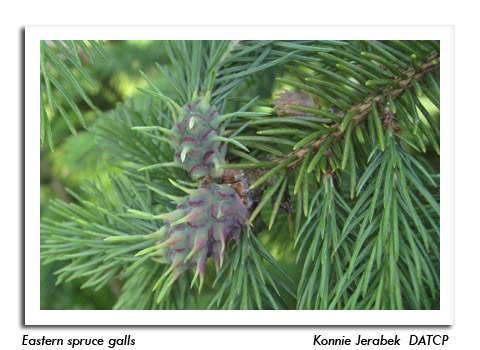
 |
|
|
Nursery & Forest
Volume 59 Number 17 Date 08/28/2014 INTRODUCED PINE SAWFLY - Larvae of this pine pest were defoliating white pines in Sheboygan County, according to a DATCP nursery inspector's report. The gregarious caterpillars feed in groups on the previous years' needles, consuming all the needles on a single branch before moving to another branch to feed. Damage is usually most severe in the upper half of trees, but entire trees may be defoliated during severe infestations. Insecticidal soap or conventional insecticides are effective against the young larvae if applied early in the season. Attempted control of the larger, full-grown larvae at this time of year is not recommended since most of the damage has already occurred. FALL WEBWORM - Nests or webs made by fall webworm larvae are still common throughout the state and were noted this week on birch and linden trees in a Jefferson County nursery. These characteristic webs appear later in the season than those of other web or tent making larvae in Wisconsin (e.g. eastern tent caterpillar and forest tent caterpillar). The larvae and their tents are primarily a cosmetic problem that can be easily controlled by manual removal or pruning. EASTERN SPRUCE GALL ADELGID - The pineapple-shaped galls, which form when needles are injured by adelgid feeding, were conspicuous on spruce trees in Sheboygan County in the past week. Eventually the galls dry, turn brown and split open, allowing the mature nymph inside to emerge, usually from mid-August to October. Dormant oil treatments made in October and November, or in April, are usually effective against this pest. ASH FLOWER GALL MITE - A heavy infestation of this tiny eriophyid mite was observed on 'Leprechaun' ash trees in a Washington County nursery. The mite feeds on the male flower clusters of ash trees, causing the clusters to enlarge into irregularly-shaped, unsightly masses that appear as dried brownish-black clumps by autumn. The galls may persist on trees for 1-2 years, but they do not seriously harm the tree and are considered only an aesthetic problem. -- Ellen Hermanson, DATCP Nursery Inspector GLADIOLUS WHITE BREAK - Gladiolus plants infected with virus were found this week in Sawyer County. The condition is commonly called "white break" and is caused by cucumber mosaic virus. Symptoms include whitish breaks in the coloration along the edges of flowers, and white or yellowish spots on the foliage. Infected plants may also produce deformed corms. The causal virus is transmitted on cutting tools and by probing aphids. Control includes continual rogueing (pulling and destroying) of symptomatic plants, sound cultural practices, and in severe cases, control of the insect vector. -- Tim Allen, DATCP Nursery Inspector 





|
|
|